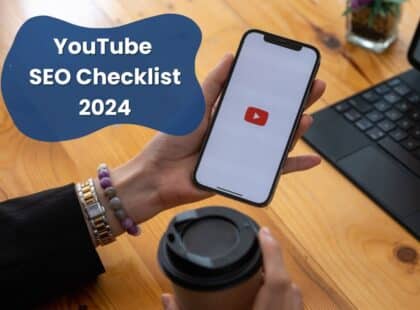
What Is YouTube SEO? 2024 YouTube SEO Checklist
In today’s fast-paced digital world, video content has become a crucial me [...]

In the rapidly evolving digital world, marketing automation has become an indispensable tool for entrepreneurs, small businesses, and startups to streamline their customer interactions and improve business growth. By automating marketing processes, these businesses can nurture leads, improve customer engagement, and drive conversions. This article will explore how marketing automation can enhance the customer journey, discuss key marketing automation events, and demonstrate how startups can leverage automation to improve efficiency and customer satisfaction.
Table of Contents
Customer journey automation refers to using technology and software tools to automate the different stages a customer goes through, from awareness to post-purchase. With the help of marketing automation, businesses can deliver personalized content at the right time, addressing specific customer needs without manual intervention. This automation ensures that customers feel engaged with your brand while your team can focus on higher-level strategic efforts.
Based on the data from Exploding Topics, 10% of customer journeys are now fully automated.
Businesses that adopt marketing automation tools can significantly improve customer engagement without manual intervention. These tools allow companies to streamline their efforts, making customer journey automation more efficient and personalized.
Customer journey automation plays a critical role in providing a seamless, consistent, and personalized experience for each customer. It allows businesses to stay connected with their customers throughout the entire journey, from the initial point of contact to post-purchase engagement. Without automation, managing this journey manually can be time-consuming and prone to errors.
Based on the data from Backlinko, marketing automation plays a key role in streamlining customer journey processes. For example, 91% of successful marketers consider marketing automation as “very important” to their marketing strategies. Additionally, automated emails generate 320% more revenue than non-automated emails, showcasing how automation enhances both efficiency and effectiveness when managing customer interactions throughout the journey.
Mapping a customer journey is the first step toward effectively implementing marketing automation. This involves identifying and understanding the different stages that a customer goes through as they interact with your brand. Here’s a breakdown of the key steps in mapping the customer journey:
Instead of creating a customer journey map from scratch, leverage available templates. HubSpot offers free templates for mapping a buyer’s journey, customer life cycle, and lead nurturing, which can save time and help align your teams around a consistent customer experience.
Before you start mapping, define clear objectives. Ask yourself what you want to achieve, who the map is for, and what customer experience it should focus on. Without a clear objective, the map might lose its direction.
Research and profile your customer personas to understand their goals. Use surveys, user testing, and analytics to gather feedback from actual customers or prospects. This ensures that you’re mapping the journey based on real customer experiences.
Focus on one or two key personas for your map. Tracking too many personas in one map can lead to confusion. Start with your most common persona and map their journey with your company. Later, you can create separate maps for other personas.
Identify all the touchpoints where customers interact with your brand, such as your website, social media, and customer support. Analyzing these points will help you understand where customers might face challenges or drop off in their journey.
Your customer journey map should highlight the resources currently available and those needed to improve the customer experience. This could include new tools or software that would streamline customer interactions.
Test the customer journey yourself, walking through each stage as a customer would. This firsthand experience will reveal pain points, inefficiencies, or areas for improvement in the journey.
Once the map is complete, analyze the data. Look for areas where customer needs aren’t being met, such as high bounce rates or frequent drop-offs, and use these insights to improve the customer experience.
Customer journeys change over time, especially with new products or services. Regularly update your map to reflect these changes and ensure that it continues to provide value.
By automating each of these steps, businesses can ensure that they’re delivering the right message at the right time, effectively guiding customers through the entire journey.
Key Events in Marketing Automation involve several critical components that streamline and enhance marketing efforts:
By leveraging these marketing automation events, businesses can create a more personalized and effective customer journey.
The advantages of automating the customer journey are substantial, particularly for startups and small businesses. Here are some key benefits:
Customer journey mapping and marketing automation are two powerful tools that work hand-in-hand to enhance your marketing strategy. Customer journey mapping provides a detailed look at each step a customer takes when interacting with your brand, while marketing automation ensures that the right messages are delivered at the right time to guide them through the journey.
For instance, if a customer visits your pricing page multiple times without making a purchase, marketing automation can trigger a personalized email offering them more information or a discount to encourage a purchase. Without automation, this level of personalization would be incredibly difficult to manage manually.
Together, customer journey mapping and marketing automation allow businesses to maintain a consistent, personalized approach to customer engagement, resulting in higher conversions and customer satisfaction.
In a world where efficiency and personalization are key to success, marketing automation is an invaluable tool for entrepreneurs, small businesses, and startups. By automating the customer journey, businesses can not only increase efficiency but also deliver personalized, timely messages that guide customers through every stage of their journey.
If you’re ready to see how marketing automation can enhance your customer journey, reach out to Marketing Spotlight for a free consultation and get a custom marketing automation strategy tailored to your business. Automating your marketing efforts will help you stay ahead of the competition, build stronger customer relationships, and maximize the potential of each customer interaction.

I’ve had a smooth experience working with Marketing Spotlight team. They helped me develop a website, create a marketing strategy and set up marketing automation.

Marketing Spotlight transformed our marketing efforts with their automation services. The seamless integration and efficiency they brought to our campaigns have been a game-changer. Our customer engagement in the UAE has never been better!
The meeting link will be shared with you via email after you finish booking a call.